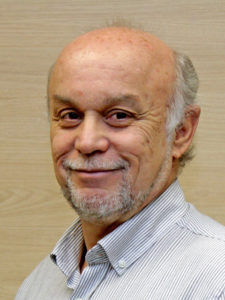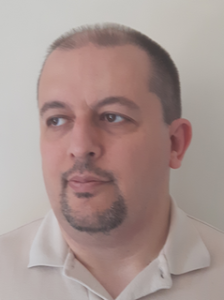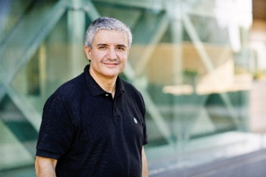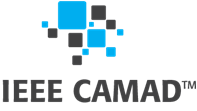All times are in CEST time zone.
Monday, 14 September
| 08:45 ‑ 09:00 |
Opening Ceremony |
|
|
|
|
|
|
| 09:00 ‑ 10:30 |
Session 1 |
Intelligent Radio Resource Management for 5G and Beyond |
|
|
|
Chair |
Firooz Saghezchi (Instituto de Telecomunicações) |
|
|
|
|
|
| |
Adaptive Spectrum Allocation for 5G Wireless Communication Scenarios
Noelia Correia; Faroq Al-Tam; Jonathan Rodriguez |
|
|
|
|
|
|
|
|
Deep PC-MAC: A deep reinforcement learning pointer-critic media access protocol
Faroq Al-Tam; Andriy Mazayev; Noelia Correia; Jonathan Rodriguez |
|
|
|
|
|
|
|
|
5GMEDE – 5G Mobile Edge Computing with Enriched Radio Network Information Services
Valdemar C. Monteiro |
|
|
|
|
|
|
|
|
EXPLOR – A Novel Holistic Numerical Platform for Converged Optical-Wireless B5G Networks
Zoran Vujicic; Jonathan Rodriguez; Nikos Passas; Rahat Iqbal; Tomasz Maniak; Eftychia Datsika; John S Vardakas; Charalampos Karyotis; Sherif Adeshina Busari; Christos Verikoukis |
|
|
|
|
|
|
|
|
Radio Resource Scheduling with Deep Pointer Networks and Reinforcement Learning
Faroq Al-Tam; Andriy Mazayev; Noelia Correia; Jonathan Rodriguez |
|
|
|
|
|
|
|
|
Multi-objective Hybrid Scheduler enabling Efficient Resource Management for 5G UDN
Sherif Adeshina Busari; Firooz B. Saghezchi; Shahid Mumtaz; Jonathan Rodriguez |
|
|
|
|
|
| 10:30 ‑ 11:00 |
Coffee Break |
|
|
|
|
|
|
| 11:00 ‑ 12:30 |
Session 2 |
IoT and Assisted Living Technologies |
|
|
|
Chair |
Tamara Al-Shayea (Univ. of Nicosia) |
|
|
|
|
|
| |
Classification of Psychosomatic’s Symptoms of Depression: Iliou Versus PCA Preprocessing Methods
Theodoros Iliou; Georgia Konstantopoulou; Konstantinos Anastasopoulos; Christina Lymperopoulou; Georgios Mantas; Jonathan Rodriguez; Dimitrios Lymberopoulos; George Anastasopoulos |
|
|
|
|
|
|
|
|
On the relief of Phantom Limp Pain using Augmented Reality and Edge Computing
Eleftheria Areti Marinou; Christos Tselios; Pantelis Theocharakis |
|
|
|
|
|
|
|
|
Successful Delivery in VANETs with Damaged Infrastructures Based on Double Cluster Head Selection
Grace Khayat; Constandinos X. Mavromoustakis; George Mastorakis; Jordi Mongay Batalla; Hoda Maalouf; Shahid Mumtaz; Evangelos Pallis |
|
|
|
|
|
|
|
|
Physical Stimuli and Emotions: EDA Features Analysis from a Wrist-Worn Measurement Sensor
Stefania Cecchi; Agnese Piersanti; Angelica Poli; Susanna Spinsante |
|
|
|
|
|
|
|
|
The impact of covid on network utilization: an analysis of domain popularity
Antonia Affinito; Alessio Botta; Giorgio Ventre |
|
|
|
|
|
|
|
|
Modified Machine Learning Techique for Curve Fitting on Regression Models for COVID-19 projections
Andreas Andreou; Constandinos X. Mavromoustakis; George Mastorakis; Shahid Mumtaz; Jordi Mongay Batalla; Evangelos Pallis |
|
|
| 12:30 ‑ 13:30 |
Lunch Break |
|
| 13:30 ‑ 15:00 |
Keynote 1 |
|
| |
Chair |
Luca Foschini (Univ. of Bologna) |
Nelson Fonseca (Univ. of Campinas, Brazil), “Federated Learning: State of the Art, Current Trends and Challenges”
 It is estimated that the number of interconnected Internet of Things (IoT) devices and smartphones surpass 8 billion and that 800 Zeta Bytes of data worldwide will be generated by 2021. Moreover, the great potentiality of transforming these data into useful information by employing machine learning (ML) techniques have been widely demonstrated. However, ML processing and training of supervised learning models have been carried out in centralized data centers with massive processing power and storage. Edge/fog computing has addressed the limitations of cloud computing, especially the provisioning of fast response time to applications with strict latency requirements. Besides, federated learning (FL) has enabled the distributed processing of machine learning models at the edge of the network and collaborative model training without exposing a user’s data. In FL, distributed entities send their model updates, to an FL server for aggregation. The steps are repeated in multiple rounds until an acceptable accuracy level is achieved. FL brings numerous advantages, such as data privacy, efficient bandwidth usage, and low latency. However, as a technology still in its infancy, there are still many challenges to overcome. This talk will overview the federate learning technology state of the art and discuss the challenges its advancement face.
It is estimated that the number of interconnected Internet of Things (IoT) devices and smartphones surpass 8 billion and that 800 Zeta Bytes of data worldwide will be generated by 2021. Moreover, the great potentiality of transforming these data into useful information by employing machine learning (ML) techniques have been widely demonstrated. However, ML processing and training of supervised learning models have been carried out in centralized data centers with massive processing power and storage. Edge/fog computing has addressed the limitations of cloud computing, especially the provisioning of fast response time to applications with strict latency requirements. Besides, federated learning (FL) has enabled the distributed processing of machine learning models at the edge of the network and collaborative model training without exposing a user’s data. In FL, distributed entities send their model updates, to an FL server for aggregation. The steps are repeated in multiple rounds until an acceptable accuracy level is achieved. FL brings numerous advantages, such as data privacy, efficient bandwidth usage, and low latency. However, as a technology still in its infancy, there are still many challenges to overcome. This talk will overview the federate learning technology state of the art and discuss the challenges its advancement face.
| 15:00 ‑ 15:30 |
Coffee Break |
|
|
|
|
|
|
| 15:30 ‑ 17:00 |
Session 3 |
Optimization Techniques |
|
|
|
Chair |
Murat Simsek (Univ. of Ottawa) |
|
|
|
|
|
| |
Performance of Metaheuristic Algorithms for the Controller Placement Problem in SDN
Ana Carolina de Oliveira Christófaro; Marcelo M Carvalho; Daniel G Silva |
|
|
|
|
|
|
|
|
A new reputation-aware client selection scheme for federated learning within mobile environments
Yuwei Wang; Burak Kantarci |
|
|
|
|
|
|
|
|
Drone Trajectory Optimization using Genetic Algorithm with Prioritized Base Stations
Tianrui Qiao; Yusuf A. Sambo; Muhammad Ali Imran; Wasim Ahmad |
|
|
|
|
|
|
|
|
Energy-efficient resource allocation in wireless LANs under non-linear capacity constraints
Rosario G. Garroppo; Gianfranco Nencioni; Luca Tavanti; Bernard Gendron; Maria Grazia Scutellà |
|
|
|
|
|
|
|
|
Gambling on fairness: a fair scheduler for IIoT communications based on the shell game
Giuseppe Portaluri; Stefano Giordano |
|
|
|
|
|
|
|
|
Correlated Deep Q-learning based Microgrid Energy Management
Hao Zhou; Melike Erol-Kantarci |
|
|
|
|
|
| 17:00 – 18:30 |
Session 4
|
IoT Services and Applications |
|
|
|
Chair |
Luca Foschini (Univ. of Bologna) |
|
|
|
|
|
| |
A Data Driven Learning System Based on Natural Intelligence for an Intelligent IoT Virtual Assistant
Nicholas Dmytryk; Aris Leivadeas |
|
|
|
|
|
|
|
|
Network Performance Evaluation of a LoRa-based IoT System for Crop Protection Against Ungulates
Mike Ojo; Davide Adami; Stefano Giordano |
|
|
|
|
|
|
|
|
IoT Traffic Multi-Classification Using Network and Statistical Features in a Smart Environment
Aroosa Hameed; Aris Leivadeas |
|
|
|
|
|
|
|
|
Short-term Individual Electric Vehicle Charging Behavior Prediction Using Long Short-term Memory Networks
Ahmed Shaharyar Khwaja; Bala Venkatesh; Alagan Anpalagan |
|
|
|
|
|
|
|
|
Evaluating Traffic Signs Detection using Faster R-CNN for Autonomous driving
Rishabh Kukreja; Sonam Rinchen; Binod Vaidya; Hussein Mouftah |
|
|
|
|
|
|
|
|
Machine Learning-Driven Event Characterization under Scarce Vehicular Sensing Data
Nima Taherifard; Murat Simsek; Charles Lascelles; Burak Kantarci |
|
|
Tuesday, 15 September
| 09:00 ‑ 10:30 |
Tutorial – Part 1
|
|
| |
Chair
|
Stefano Giordano (Univ. of Pisa)
|
| Fabrizio Granelli (Univ. of Trento, Italy) and Frank Fitzek (5GLabs, Dresden, Germany),“Computing in communication networks – From theory to practice”
 A big step lies ahead, when moving from today’s 4G cellular networks to tomorrow’s 5G network. Today, the network is used for content delivery, e.g. voice, video, data. Tomorrow, the 5G network (and possibly beyond that) will be fully softwarized and programmable, with new degrees of freedom. The aim of the tutorial is to illustrate how the emerging paradigms of Software Defined Networking, Network Function Virtualization, and Information Centric Networking will impact on the development of future systems and networks, both from the theoretical/formal as well as from the practical perspective. Main focus will be on mobile networks, i.e. 5G and beyond. A big step lies ahead, when moving from today’s 4G cellular networks to tomorrow’s 5G network. Today, the network is used for content delivery, e.g. voice, video, data. Tomorrow, the 5G network (and possibly beyond that) will be fully softwarized and programmable, with new degrees of freedom. The aim of the tutorial is to illustrate how the emerging paradigms of Software Defined Networking, Network Function Virtualization, and Information Centric Networking will impact on the development of future systems and networks, both from the theoretical/formal as well as from the practical perspective. Main focus will be on mobile networks, i.e. 5G and beyond.
The tutorial will provide a comprehensive overview of the individual building blocks (software defined networking; network function virtualization; information centric networks) enabling the concept of computing in future networks, starting from use cases and concepts over technological enablers (Mininet; Docker) and future innovations (machine learning; network coding; compressed sensing) to implementing all of them on personal computers.
Practical ha nds-on activities will be proposed, with realistic use cases to bridge theory and implementation by several examples, through the usage of a pre-built ad-hoc Virtual Machine (ComNetsEmu) that can easily be extended for new experiments. The instructions to download the Virtual Machine will be provided in advance of the event. The main objective of the tutorial will be to expose attendees to the most recent technologies in the field of networking and teach them how to use them in a real setup in the “hands-on” session. nds-on activities will be proposed, with realistic use cases to bridge theory and implementation by several examples, through the usage of a pre-built ad-hoc Virtual Machine (ComNetsEmu) that can easily be extended for new experiments. The instructions to download the Virtual Machine will be provided in advance of the event. The main objective of the tutorial will be to expose attendees to the most recent technologies in the field of networking and teach them how to use them in a real setup in the “hands-on” session.
A related book written by the two presenters “Computing in Communication Networks” (published in 2020 by Elsevier) provides in-depth description of the concepts and hands-on activities presented in the tutorial, to enable interested attendees to learn additional details on the reviewed technologies.
IMPORTANT INFORMATION: Attendees of the tutorial are recommended to install the VM for the hands-on activities following the instructions indicated here:
https://git.comnets.net/public-repo/comnetsemu |
| 10:30 ‑ 11:00 |
Coffee Break |
|
|
| 11:00 ‑ 12:30 |
Tutorial – Part 2
|
|
| |
Chair
|
Stefano Giordano (Univ. of Pisa) |
| Fabrizio Granelli (Univ. of Trento, Italy) and Frank Fitzek (5GLabs, Dresden, Germany),“Computing in communication networks – From theory to practice”
Refer to part 1 for further details.
IMPORTANT INFORMATION: Attendees of the tutorial are recommended to install the VM for the hands-on activities following the instructions indicated here:
https://git.comnets.net/public-repo/comnetsemu |
| 12:30 ‑ 13:30 |
Lunch Break |
|
|
| 13:30 ‑ 15:00 |
Keynote 2 |
Emilio Calvanese Strinati (CEA-LETI, Grenoble, France), “6G and Industry 4.0 applications” |
| |
Chair
|
Rosario Garroppo (Univ. of Pisa)
|
Emilio Calvanese Strinati (CEA-LETI, Grenoble, France), “6G and Industry 4.0 applications”
 In the last years, information communication, computation and storage technologies are jointly reshaping the way we use technology, meeting the future needs of a wide range of big data and artificial intelligence applications and, paving the way for a full-customized autonomous user experience. In 2020 the 5G -Next Generation Communication Networks is expected to be operational and a global game changer from a technological, economic, societal and environmental perspective. 5G industry is intensively working today on designing, prototyping and testing fundamental technological advances to de-liver the promised performance in terms of latency, energy efficiency, wireless broadband capacity, elasticity, etc. Nevertheless, looking at the increasing requests for new services and predicting the development of new technologies within a decade from now, it is already possible to envision the need to move beyond 5G and design a new architecture incorporating new technologies to satisfy new needs at both individual and societal level.
In the last years, information communication, computation and storage technologies are jointly reshaping the way we use technology, meeting the future needs of a wide range of big data and artificial intelligence applications and, paving the way for a full-customized autonomous user experience. In 2020 the 5G -Next Generation Communication Networks is expected to be operational and a global game changer from a technological, economic, societal and environmental perspective. 5G industry is intensively working today on designing, prototyping and testing fundamental technological advances to de-liver the promised performance in terms of latency, energy efficiency, wireless broadband capacity, elasticity, etc. Nevertheless, looking at the increasing requests for new services and predicting the development of new technologies within a decade from now, it is already possible to envision the need to move beyond 5G and design a new architecture incorporating new technologies to satisfy new needs at both individual and societal level.
The keynote will first present in the context of Industrial IoT (IIoT) applications, the interdependencies between the foreseen 6G KPIs, 6G key enabling technologies and the three levels of cloud: Fog, Mobile Edge Cloud and the Central Cloud. Then, the keynote will cover both architecture and detail technical tools for understanding the future 6G key enabling technologies that will enable IIoT applications to meet their challenging performance targets. IIoT use cases investigated in the Europe-Taiwan 5G-CONNI project will be also detailed. The keynote will also discuss on how ‘the cloud’ will play an operational role in future IIoT wireless networks. Eventually, the keynote will present very recent results and discuss the extraordinary opportunities that Goal Oriented Communications will offer to 6G IIoT networks. Special emphasis will be given to 6G open research challenges that researchers and industry are and will investigate in the near future.
| 15:00 ‑ 15:30 |
Coffee Break |
|
|
|
|
|
|
| 15:30 ‑ 17:00 |
Session 5 |
5G systems |
|
|
|
Chair |
Melike Erol-Kantarci (Univ. of Ottawa) |
|
|
|
|
|
|
|
| |
Very Compact Reconfigurable Planar Filter With Wide-stopband Performance for Sub-6 GHz 5G Systems
Yasir Ismael Abdulraheem Al-Yasir; Naser Ojaroudi Parchin; Ahmed Maan Abdulkhaleq; Raed A Abd-Alhameed; Jonathan Rodriguez |
|
|
|
|
|
|
|
|
A Planar Diversity Loop Antenna Array with Improved Properties for 5G Mobile Phones
Naser Ojaroudi Parchin; Yasir Ismael Abdulraheem Al-Yasir; Mohammad Alibakhshikenari; Ahmed Maan Abdulkhaleq; Haleh Jahanbakhsh Basherlou; Ernesto Limiti; Jonathan Rodriguez; Raed A Abd-Alhameed |
|
|
|
|
|
|
|
|
Service-Based Coverage for Physical Layer Security with Multi-Point Coordinated Beamforming
Utku Ozmat; Mehmet F Demirkol; Mehmet Akif Yazici |
|
|
|
|
|
|
|
|
Prediction of mobile networks traffic: enhancement of the NMLS technique
Rosario G. Garroppo; Christian Callegari |
|
|
|
|
|
|
|
|
Low Complexity PIC-MMSE Detector for LDS Systems over Frequency-Nonselective Channels
Mitchell Fantuz; Michel Kulhandjian; Claude D’Amours |
|
|
|
|
|
|
|
|
Reinforcement Learning for Dynamic Resource Optimization in 5G Radio Access Network Slicing
Yi Shi; Yalin E Sagduyu; Tugba Erpek |
|
|
|
|
|
|
|
|
|
|
| 17:00 – 18:30 |
Covid-19 Panel |
|
|
|
| |
Chair
|
Luca Foschini (Univ. of Bologna)
|
|
|
| |
|
|
|
Burak Kantarci (Univ. of Ottawa, Canada)
Giovanni Lombardi (CUBIT/Univ. of Pisa, Italy)
Luca Foschini (Univ. of Bologna, Italy)
Adlen Ksentini (EURECOM, France)
Mariaelena Occhipinti (Imaging Institute Italian Swiss, Switzerland) |
|
|
Wednesday, 16 September
| 09:00 ‑ 10:30 |
Session 6 |
Next Generation Networks |
|
|
|
Chair |
Gregorio Procissi (Univ. of Pisa)
|
|
|
|
|
|
|
|
| |
Data Stream Processing in Software Defined Networks: Perspectives and Challenges
Alessandra Fais; Gregorio Procissi; Stefano Giordano; Francesco Oppedisano |
|
|
|
|
|
|
|
|
Experimenting with SRv6: a Tunneling Protocol supporting Network Slicing in 5G and beyond
Marco Gramaglia; Vincenzo Sciancalepore; Francisco Javier Fernandez-Maestro; Ramon Perez; Pablo Serrano; Albert Banchs |
|
|
|
|
|
|
|
|
A Lightweight Performance Enhancing Proxy for Evolved Protocols and Networks
Zsolt Krämer; Sándor Molnár; Marcus Pieska; Attila Mihály |
|
|
|
|
|
|
|
|
WiFi Probes sniffing: an Artificial Intelligence based approach for MAC addresses de-randomization
Marco Uras; Raimondo Cossu; Enrico Ferrara; Ovidiu Bagdasar; Antonio Liotta; Luigi Atzori |
|
|
|
|
|
|
|
|
Spatially Representative Online Big Data Sampling for Smart Cities
Isam Mashhour Al Jawarneh; Paolo Bellavista; Rebecca Montanari; Luca Foschini; Antonio Corradi |
|
|
| 10:30 ‑ 11:00 |
Coffee Break |
|
|
|
|
|
|
| 11:00 ‑ 12:30 |
Session 7 |
Industrial IoT |
|
|
|
Chair |
Rosario Garroppo (Univ. of Pisa) |
|
|
|
|
|
|
|
| |
A Joint Decentralized Federated Learning and Communications Framework for Industrial Networks
Stefano Savazzi; Sanaz Kianoush; Vittorio Rampa; Mehdi Bennis |
|
|
|
|
|
|
|
|
Increasing the reliability of IEEE 802.11ad for industrial applications
Rosario G. Garroppo; Maria Grazia Scutellà |
|
|
|
|
|
|
|
|
Feasibility of Commodity WiFi for Operations Control in an Autonomous Production Site
Armir Bujari; Antonio Corradi; Luca Foschini; Claudio E. Palazzi |
|
|
|
|
|
|
|
|
Improving Proximity Detection of Mesh Beacons at the Edge for Indoor and Outdoor Navigation
Maria Fazio; Antonio Celesti; Massimo Villari |
|
|
|
|
|
|
|
|
A Monitoring Application for Animal Repelling Devices in Smart Agriculture
Davide Adami; Stefano Giordano; Marialaura Tamburello |
|
|
| 12:30 ‑ 13:30 |
Lunch Break |
|
|
|
|
|
|
|
|
13:30 ‑ 14:00
|
Invited Talk
|
|
|
|
|
| |
Chair
|
Melike Erol-Kantarci (Univ. of Ottawa) |
|
|
|
| Mohamed-Slim Alouini (KAUST) , “What should 6G be ?”
The role of Internet and Communication Technology (ICT) in bringing about a revolution in almost all aspects of human life needs no introduction. It is indeed a well-known fact that the transmission of the information at a rapid pace has transformed all spheres of human life such as economy, education, and health to name a few. In this context, and as the standardization of the fifth generation (5G) of wireless communication systems (WCSs) has been completed, and 5G networks are in their early stage of deployment, the research visioning and planning of the sixth generation (6G) of WCSs are being initiated. 6G is expected to be the next focus in wireless communication and networking and aim to provide new superior communication services to meet the future hyper-connectivity demands in the 2030s. In addition, keeping in mind that urbanized populations have been the major beneficiary of the advances offered by the previous generations of WCSs and motivated by the recently adopted united nations sustainability development goals intended to be achieved by the year 2030, 6G networks are anticipated to democratize the benefits of ICT. Indeed these advantages are still not experienced by almost 4 billion people in the world who are still “unconnected or under-connected” and who suffer as such from the “digital divide”, a term coined in order to emphasize the lack of ICT infrastructure in many parts of the world. Given this background, this talk aims to (i) provide an envisioned picture of 6G, (ii) serve as a research guideline in the beyond 5G era, and (iii) go over the recently proposed solutions to provide high-speed connectivity in under-covered areas in order to serve and contribute to the development of far-flung regions. Communication Technology (ICT) in bringing about a revolution in almost all aspects of human life needs no introduction. It is indeed a well-known fact that the transmission of the information at a rapid pace has transformed all spheres of human life such as economy, education, and health to name a few. In this context, and as the standardization of the fifth generation (5G) of wireless communication systems (WCSs) has been completed, and 5G networks are in their early stage of deployment, the research visioning and planning of the sixth generation (6G) of WCSs are being initiated. 6G is expected to be the next focus in wireless communication and networking and aim to provide new superior communication services to meet the future hyper-connectivity demands in the 2030s. In addition, keeping in mind that urbanized populations have been the major beneficiary of the advances offered by the previous generations of WCSs and motivated by the recently adopted united nations sustainability development goals intended to be achieved by the year 2030, 6G networks are anticipated to democratize the benefits of ICT. Indeed these advantages are still not experienced by almost 4 billion people in the world who are still “unconnected or under-connected” and who suffer as such from the “digital divide”, a term coined in order to emphasize the lack of ICT infrastructure in many parts of the world. Given this background, this talk aims to (i) provide an envisioned picture of 6G, (ii) serve as a research guideline in the beyond 5G era, and (iii) go over the recently proposed solutions to provide high-speed connectivity in under-covered areas in order to serve and contribute to the development of far-flung regions. |
|
|
|
| 14:00 ‑ 15:00 |
Industrial Panel |
|
|
|
|
| |
Chair
|
Stefano Giordano (Univ. of Pisa) |
|
|
|
|
Giada Landi (Nextworks), “Architectures, testbeds and methodologies for experimental validation of Industry 4.0 services in 5G infrastructures”
Sergio Borghese (Netresults), “Test execution in Python toward a description driven testing platform”
Luca Tavanti (CUBIT), “Intelligent edge devices for vertical applications“ |
|
|
|
| 15:00 ‑ 15:30 |
Coffee Break |
|
|
|
|
|
|
|
|
| 15:30 ‑ 17:00 |
Session 8
|
Towards 5G and Beyond: An Era of Agile, Brisk and Perceptive Networking |
|
|
|
|
Chair |
Christos Tselios (Citrix ) |
|
|
|
|
|
|
|
|
|
| |
On the Inherent Physical-Layer Security of Receive Spatial Modulation Systems
Abdelrahman Abushattal; Saud Althunibat; Marwa Qaraqe; Huseyin Arslan |
|
|
|
|
|
|
|
|
|
|
Mobility Dependent Hybrid RF/FSO Backhaul in UAV Assisted Cellular Networks
Muhammad Usman; Saud Althunibat; Khalid A. Qaraqe |
|
|
|
|
|
|
|
|
|
|
Head(er)Hunter: Fast Intrusion Detection using Packet Metadata Signatures
Eva Papadogiannaki; Dimitris Deyannis; Sotiris Ioannidis |
|
|
|
|
|
|
|
|
|
|
Efficient cooperative transmissions with dynamic clustering in realistically designed small cells
Panagiotis Georgakopoulos; Tafseer Akhtar; Christos Tselios; Ilias Politis |
|
|
|
|
|
|
|
|
|
|
A lightweight security framework for network coding enabled mobile small cells
Vipindev Adat; Ilias Politis; Stavros Kotsopoulos |
|
|
|
|
|
|
|
|
|
|
Graph based Cooperative Localization for Connected and Semi-Autonomous Vehicles
Nikos Piperigkos; Aris S. Lalos; Kostas Berberidis |
|
|
|
| 17:00 – 18:30 |
Closing Ceremony |
|
 It is estimated that the number of interconnected Internet of Things (IoT) devices and smartphones surpass 8 billion and that 800 Zeta Bytes of data worldwide will be generated by 2021. Moreover, the great potentiality of transforming these data into useful information by employing machine learning (ML) techniques have been widely demonstrated. However, ML processing and training of supervised learning models have been carried out in centralized data centers with massive processing power and storage. Edge/fog computing has addressed the limitations of cloud computing, especially the provisioning of fast response time to applications with strict latency requirements. Besides, federated learning (FL) has enabled the distributed processing of machine learning models at the edge of the network and collaborative model training without exposing a user’s data. In FL, distributed entities send their model updates, to an FL server for aggregation. The steps are repeated in multiple rounds until an acceptable accuracy level is achieved. FL brings numerous advantages, such as data privacy, efficient bandwidth usage, and low latency. However, as a technology still in its infancy, there are still many challenges to overcome. This talk will overview the federate learning technology state of the art and discuss the challenges its advancement face.
It is estimated that the number of interconnected Internet of Things (IoT) devices and smartphones surpass 8 billion and that 800 Zeta Bytes of data worldwide will be generated by 2021. Moreover, the great potentiality of transforming these data into useful information by employing machine learning (ML) techniques have been widely demonstrated. However, ML processing and training of supervised learning models have been carried out in centralized data centers with massive processing power and storage. Edge/fog computing has addressed the limitations of cloud computing, especially the provisioning of fast response time to applications with strict latency requirements. Besides, federated learning (FL) has enabled the distributed processing of machine learning models at the edge of the network and collaborative model training without exposing a user’s data. In FL, distributed entities send their model updates, to an FL server for aggregation. The steps are repeated in multiple rounds until an acceptable accuracy level is achieved. FL brings numerous advantages, such as data privacy, efficient bandwidth usage, and low latency. However, as a technology still in its infancy, there are still many challenges to overcome. This talk will overview the federate learning technology state of the art and discuss the challenges its advancement face. In the last years, information communication, computation and storage technologies are jointly reshaping the way we use technology, meeting the future needs of a wide range of big data and artificial intelligence applications and, paving the way for a full-customized autonomous user experience. In 2020 the 5G -Next Generation Communication Networks is expected to be operational and a global game changer from a technological, economic, societal and environmental perspective. 5G industry is intensively working today on designing, prototyping and testing fundamental technological advances to de-liver the promised performance in terms of latency, energy efficiency, wireless broadband capacity, elasticity, etc. Nevertheless, looking at the increasing requests for new services and predicting the development of new technologies within a decade from now, it is already possible to envision the need to move beyond 5G and design a new architecture incorporating new technologies to satisfy new needs at both individual and societal level.
In the last years, information communication, computation and storage technologies are jointly reshaping the way we use technology, meeting the future needs of a wide range of big data and artificial intelligence applications and, paving the way for a full-customized autonomous user experience. In 2020 the 5G -Next Generation Communication Networks is expected to be operational and a global game changer from a technological, economic, societal and environmental perspective. 5G industry is intensively working today on designing, prototyping and testing fundamental technological advances to de-liver the promised performance in terms of latency, energy efficiency, wireless broadband capacity, elasticity, etc. Nevertheless, looking at the increasing requests for new services and predicting the development of new technologies within a decade from now, it is already possible to envision the need to move beyond 5G and design a new architecture incorporating new technologies to satisfy new needs at both individual and societal level.




